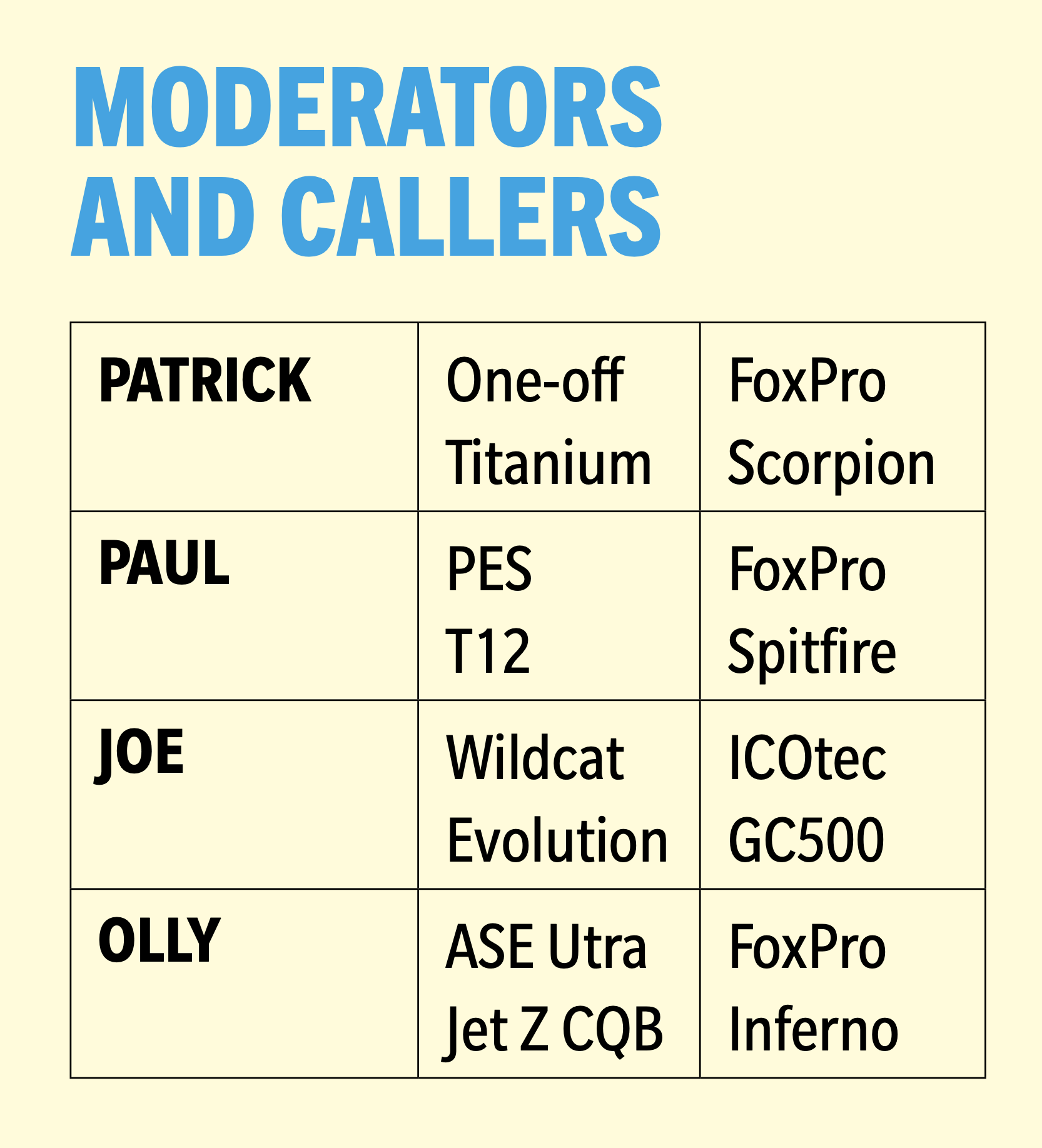Win CENS ProFlex DX5 earplugs worth £1,149 – enter here
Useful foxing equipment
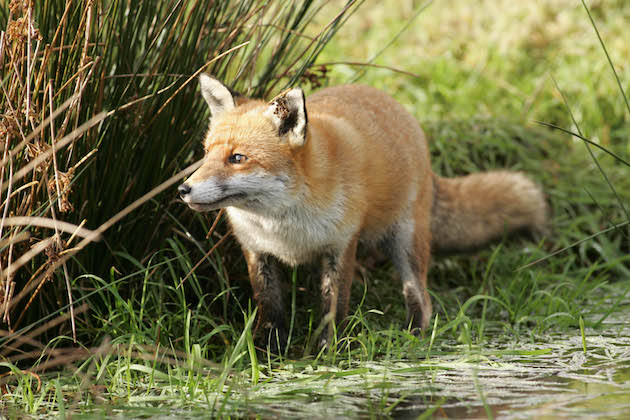 Fox
Usd 27 may 15 on your shoot
Fox
Usd 27 may 15 on your shoot
When it comes to useful foxing equipment , there’s so much conflicting advice around that I thought it would make sense to look at what’s actually used out in the field.
In this enterprise I have chosen to focus on four experienced fox shooters, including me, Paul, my usual shooting partner, and Olly and Joe, who both generally shoot on their own.
Rifles and ammo for foxing
Let’s start with rifle and ammo choices for foxing. Paul uses a Browning X-Bolt in .22-250. He loves the make and has several of these guns, in both rifled and shotgun form. He uses Prvi Partizan 55-grain soft point ammunition through it, which, although at the cheaper end of the scale, certainly knocks over a lot of foxes. His take is they’re more than accurate enough when you’re shooting off sticks.
Olly uses a Nosler M48 Varmint chambered in .204 Ruger, but is far more discerning about his ammunition, using hand-loaded rounds comprising 39-grain Sierra BlitzKing bullets over Vihtavuori N140 powder, encased in Nosler brass and with Federal primers. He goes to enormous lengths to measure and document everything.
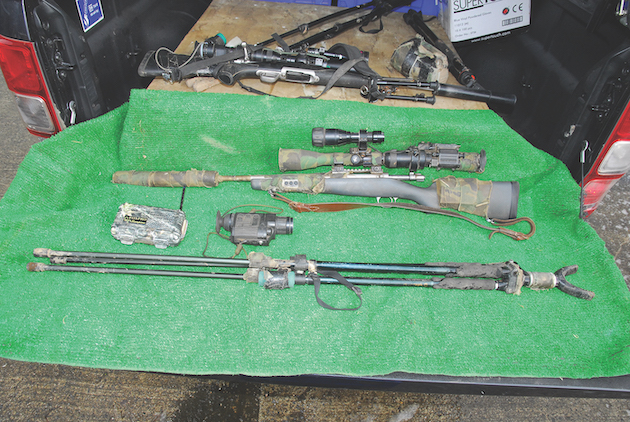
One glance at my kit will tell you that it gets used a lot. Nearest are my Vanguard Quest T62U tripod sticks and above them to the left is my Foxpro Scorpion caller. The model hasn’t been made for years; but I like it because it’s small enough to go in my pocket. To the right of that is my HD38S thermal spotter (which has a shuttered eyepiece fitted to reduce back-scatter); and above that my Kimber Montana in .204 Ruger.
Like Olly, I also use .204 Ruger and hand-load with 39-grain Sierra BlitzKing bullets and Federal primers, but I use them over Hodgdon BL-C(2) powder inside Hornady brass. These are fired through my Kimber Montana. My view is that having confidence in your shot is everything, and if I believe my ammunition is the best I can make it, I’ll shoot better.
Joe favours off-the-shelf factory Hornady Superformance ammo for his Tikka T3 Lite in .204 Ruger as he doesn’t have the time or inclination to reload at home. Although it costs more, he feels it’d take a long time to fire enough shots to pay for all the reloading equipment and, as its performance is so good, he also gains confidence by using it.
Night vision for foxing
Joe uses an Armasight Drone Pro dedicated set-up whereas Paul, Olly and I all use ex-military PVS-14 add-ons. Paul’s is on the back of a Zeiss Conquest 4-16×50, Olly’s is fitted to a Sightron SIII 6-24×50, and mine is coupled with a Swarovski Z6 3-18×50. The three of us who use the PVS-14 have the opinion that if you have the magnification set correctly, all you need to do is switch it on and you’re ready to pull the trigger.
Joe loves his Drone Pro, but we rag him endlessly that it takes him too long to get everything adjusted — the 10x magnification also makes his target acquisition slower. Regarding infrared illumination, Olly and Paul both use the Starlight Dragonfly , and Joe uses the Drone Pro XLR illuminator. I, on the other hand, generally use a Night Saber by Ludicrous Lumens, a Sniper Hog from Best Fox Call or a Black Sun by Night Vision Store. All three have similar performance, so they get switched around between my rifles.
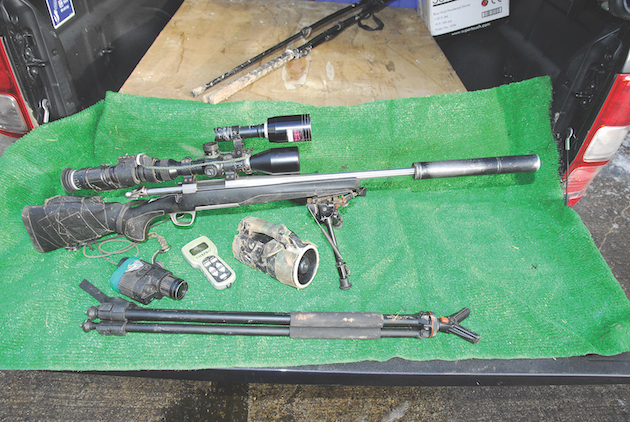
Paul is often out too and as a result his kit looks rather worn out. At the front are his Vanguard Pro T68 sticks with above them his XQ38 Pulsar thermal imager on the left and his caller centre and right. The rifle is a stainless Browning X-Bolt in .22-250.
Thermal imaging
We rely on thermal-imaging spotters as not only do they allow us to spot and home in on our quarry, but also by quickly swapping with the NV, we can get the rifles lined up more efficiently. After the shot, they help us to identify where the animals fell. Mine is the oldest model, being an ancient HD38S. When finances allow, I’ll go for a newer model, but until then I’ll make do as, after all, it finds foxes just as well as the fancier versions. Olly’s is a Quantum XQ50, Paul’s is an XQ38, and Joe’s is a Helion XP50. All four of us carry spare batteries too for these Pulsar models.
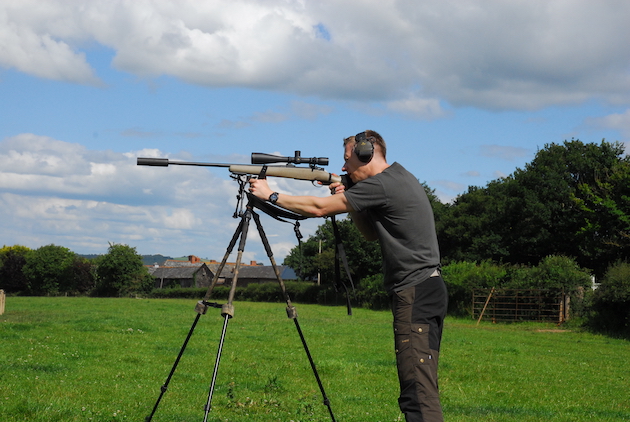
Olly is very thorough with the set up of his Nosler M48 Varmint; checking and re-checking the zeroing of his hand loaded .204 Ruger ammunition. The scope may appear to be mounted too far forwards on this daylight range session; but it is deliberate in order to allow room for the rear-mounted add-on night vision to fit.
Sticks
The other critical components in our foxing armouries are our sticks. I love my tripod-style Vanguard Quest T62U, although I have had to machine a riser to make it a bit taller. Paul uses the taller Vanguard Pro T68. Joe usually uses Gen2 trigger sticks by Primos. Olly has gone for a high-end set called the Wicked Lights Rekon Pig Saddle tripod system. Like the Primos they can be used hands-free as they have a quick release mount that locks the rifle in place, so you can leave the whole set up standing on its own. Made of carbon fibre, they are light and can be adjusted for height anywhere from prone to standing.
Olly is very thorough with the set up of his Nosler M48 Varmint, rechecking the zeroing of his hand-loaded .204 Ruger ammo. The scope may appear to be mounted too far forwards on this daylight range session, but it allows room for the rear-mounted add-on night vision to fit.
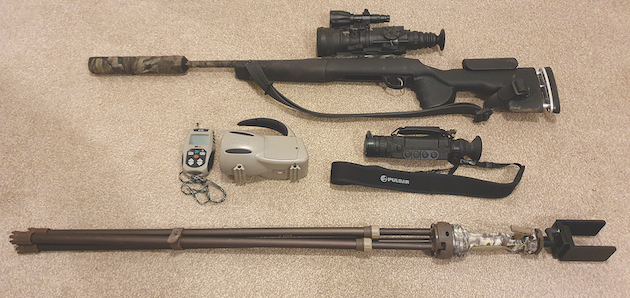
Joe’ss kit: At the top is his Tikka T3 Lite Stainless in .204 Ruger with a GRS stock and Wildcat Evolution moderator. It is topped off with a Drone Pro dedicated NV and IR illuminator by Armasight. The thermal imager is a Pulsar XP50 (which; like mine; has a shuttered eyepiece) and the caller is an IcoTEC GC500. At the front are his Gen2 Primos trigger sticks.
Patrick’s top tips for foxing
If you are considering buying any of the main items we’ve discussed here, be it rifle, night vision, thermal spotter or sticks, my suggestion would be to take your time and make sure they are appropriate to your physical specifics and particular needs. In other words, that the optical devices work with your visual capabilities (everyone’s eyes are different); that the sticks are the right height; and that the type of rifle suits its intended use. Varmint guns, for example, are built very heavily. While they’re ideal for shooting off the back of a 4×4, they’re not recommended if you’re going to have to carry them very far.
Take a look
[deal-block url=”https://www.amazon.co.uk/Fox-Pro-PATRIOT-Patriot-Digital/dp/B0749YWLWX” image_url=”https://keyassets.timeincuk.net/inspirewp/live/wp-content/uploads/sites/6/2021/04/FoxPro-135×100.jpg” image_id=”120727″ cta_text=”View deal”]FoxPro Patriot Digital Caller £173.05
[/deal-block]
[deal-block url=”https://www.amazon.co.uk/ICOtec-GC320-Decoy-Combo-Icotec/dp/B00Y39YQK4″ image_url=”https://keyassets.timeincuk.net/inspirewp/live/wp-content/uploads/sites/6/2021/04/icotec-1-135×100.jpg” image_id=”120730″ cta_text=”View Deal”]ICOtec GC320 Call / Decoy Combo by Icotec £264.31
[/deal-block]
Related Articles
Get the latest news delivered direct to your door
Subscribe to Shooting Times & Country
Discover the ultimate companion for field sports enthusiasts with Shooting Times & Country Magazine, the UK’s leading weekly publication that has been at the forefront of shooting culture since 1882. Subscribers gain access to expert tips, comprehensive gear reviews, seasonal advice and a vibrant community of like-minded shooters.
Save on shop price when you subscribe with weekly issues featuring in-depth articles on gundog training, exclusive member offers and access to the digital back issue library. A Shooting Times & Country subscription is more than a magazine, don’t just read about the countryside; immerse yourself in its most authoritative and engaging publication.






